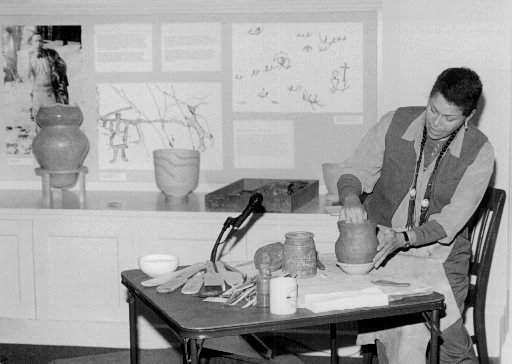 Ramona
Peters - Nosapocket
Ramona
Peters - Nosapocket Ramona
Peters - Nosapocket
Ramona
Peters - Nosapocket

When we understood ourselves as vessels who held love to share, Pottery was elaborate, sacred and magical. Reviving this art form, that left my people around 1700, has revealed far more than a clay modeling technique. The shape teaches first about combined male/female energies used as the foundation of our cooking pots. Balancing the male/female shapes physically and energetically gives birth to the spirit essence of each pot . The body of each pot is female, round and full. It is the place of nuturance where animal, vegetable, mineral plus the elements of earth, fire, water and air combine to strengthen human life forces. The collar or top of the pots are male which often have four points representing the four directions where we seek food and knowledge. The designs on the collars are usually incised lines paralleling each other to create a picture, like thought waves paralleling to achieve awareness. The bottom of the pot is pointed yet not sharp, allowing it to sit in the coals without smothering them.
The pot builders were keenly aware of chemical combinations best suited for their wares. By crushing specific rocks, shells and adding prepared solutions, they created clay bodies which attracted favorable magnetic energies from the atmosphere. These magical vessels enhanced food as medicine and increased our potential to become vessels of love and wisdom.

I was commissioned to do some artifact reproductions for Plimouth Plantation, Plymouth, Massachusetts, USA. Two items requested were 17th century Wampanoag cooking pots. I was provided with photos of shard and dimensions to reproduce my ancestors art. This experience made a major impact on my life both as an artist and as a Wampanoag. I've been continuously inspired to reinstate these pots back in the presence of the people. They are an indigenous art form that expresses the richness of our cultural understandings before European contact. I want very much for New England to embrace these pots with pride and respect.